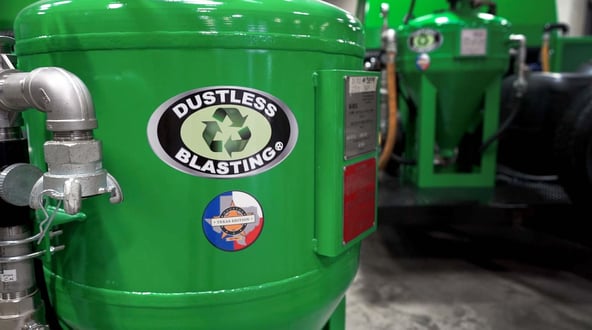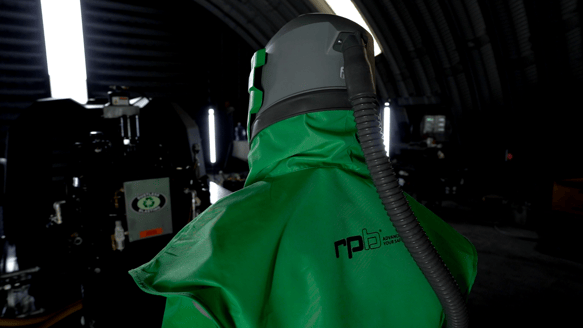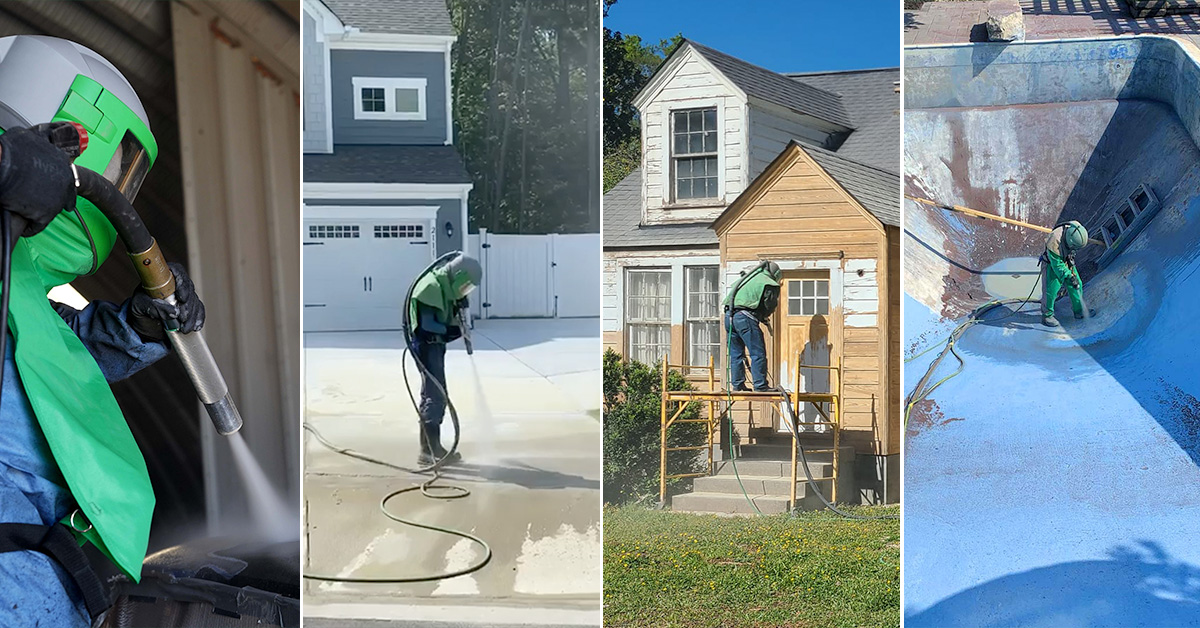
Media blasting is a process that involves the use of abrasive materials to clean, smooth, or strip surfaces. It is a common technique used in various industries, including automotive, construction, and manufacturing. Dustless Blasting is a relatively new technology in the world of media blasting, but it has quickly become a popular choice for many professionals. In this blog, we will discuss media blasters, how they work and the differences in media blasting equipment.
Learn more about what media blasting is and how it's used in this article.
What is a media blaster?

A media blaster is a machine that propels abrasives to clean and prepare surfaces. Media blasters are available in different sizes and configurations, ranging from small handheld units to large industrial machines. The abrasive media of choice is fed into the media blaster, which then propels the blast media through a nozzle at high speed onto the surface being cleaned. It's important to pick a machine that works best for the applications you'll be mostly working on. For example, if you are working large fishing vessels, you'll need a much larger and powerful media blaster than someone restoring antique furniture.
Components Required for Media Blasting
Many components in abrasive blasting systems work together to deliver an efficient and effective performance. The primary parts of media blasting equipment are listed below so you know what is needed for sandblasting:
Blast Pot

The blast pot is the main component of media blasting equipment. It holds a supply of abrasive media and distributes it through an air stream to break down materials on a surface. Dustless Blasting equipment allows for wet blasting, dry blasting and soda blasting with one easy to use machine.
Air Compressor
For a successful blasting project, it's important to obtain an air compressor that meets the required level of cubic feet per minute (CFM) to properly power your blast pot. Otherwise you could find yourself compromising on productivity and results. Luckily, you won't have to worry about pairing your blast pot with the right compressor if you choose one of our portable blasting machines that comes with both a commercial blast pot and a powerful compressor.
Moisture trap and separator tank or ADCS unit

This equipment is paired with a blasting system to remove water from compressed air before it enters the pressurized blast tank when dry blasting.
Nozzle

The nozzle directs the abrasive media through an air stream onto a surface in order to break down material. Every nozzle has a different purpose, so it's important to identify what each nozzle does and if that's the appropriate choice for your project. For more information on how to choose the right nozzle, read this article.
Blasting Media
Choosing the right blast media is crucial for the success of your project. Every abrasive has different characteristics that make them better for different surface preparation needs. Below are many types of abrasives that work on various media blasting jobs. Learn more about how to choose sand blast media in this article.
Silica Sand
Silica sand is the original sandblasting abrasive, but is no longer recommended for blasting applications due to the occupational hazard silicosis.
Garnet
This hard abrasive is fast-cutting, low-dust producing and low-consuming, excellent for removing tough coatings, paint, rust and mill scale from steel.
Crushed Glass
Made from 100% recycled glass, this abrasive creates a sharp profile and is useful in removing a variety of coatings. Crushed glass is the best media for many applications and is chemically inert, environmentally friendly and contain less than 1% free silica.
Glass Beads
Glass beads are used for general cleaning of sensitive metal surfaces; brightening grout and removing calcium deposits from tile; polishing cast iron, stainless steel and aluminum.
Steel Grit
Steel Grit blasting media is the perfect solution for intensive surface cleaning and refinement. Its softness compared to Aluminum Oxide helps create delicate, etched surfaces on steel-based materials that allow superior adhesion of paint or coatings like epoxy and rubber.
Walnut Shells
Walnut shells and other organic materials don’t cause anchor patterns, making them useful for cleaning dirt, grease, oil, carbon, scale, burrs and paint without changing the underlying substrate.
Corn Cob
Corn cob is great to use on a job like log home restoration as it is gentle enough to remove tough stains and old paint without damaging delicate substrates.
PYROXENE
As one of the tougher media choices on the market, pyroxene is proving to be able to withstand the impact and friction generated during blasting, making it an excellent option for those tougher coatings. Strong, affordable and reusable, pyroxene is currently being used on concrete, metal, plastic and more.
Accessories
One of the most important items every blaster should own is proper PPE. Make sure to wear gloves, hearing protection, eye protection or a sandblasting helmet for safety purposes.

These components work together in concert with one another to provide an efficient media blasting experience. With the use of media blasting equipment, time consuming tasks like paint removal and surface preparation can be completed quickly and with less effort.
Different kinds of Media Blasting Equipment
There are two basic types of media blasting equipment. While these media blasting equipment systems are traditionally known as sandblasting equipment, they do each serve different purposes. Media blasting equipment are divided into traditional blast cabinet systems and portable blasting systems. Let's take a look at the differences between the two machines.
Blast Cabinet Systems

Sandblast cabinets can vary greatly in size and configuration depending on the specific application, end-use or function, and setting they are used. A blasting cabinet is used by an operator to blast one part at a time. These types of systems is are typically best for small parts in machine shops or garages for touch-up of production parts, prototyping, and custom work.
Portable Media Blasters

Portable sand blasters come in a variety of sizes and types. Portable sandblasting systems are available in two types – gravity fed and pressure fed. Our blast pots employ a Venturi suction abrasive delivery design, as opposed to a gravity-fed system that is prone to clogging and has a limited range of usable blast media. The design we developed actually draws media and water from the bottom of the container before being released out the top.
What is Dustless Blasting?

Dustless Blasting is a process that uses blasting media, and compressed air to strip surfaces, but unlike most blasters on the market, ours is the most versatile and valuable portable blasting equipment because it can switch between all three blasting methods - wet blasting, dry blasting and soda blasting. Not only that, but our system uses a gravity-fed design that we mentioned above. The abrasive media used in Dustless Blasting can be varied depending on the surface being blasted, and can include materials such as crushed glass, garnet, walnut shells, baking soda and so much more. When wet blasting with our units, the mixture of water and abrasive media reduces the amount of dust produced during the blasting process, making it an environmentally friendly alternative to traditional sandblasting.
Why is Dustless Blasting a great media blaster?
-
It is efficient for media blasting
Dustless Blasting is an efficient process that can remove paint, rust, and other coatings from surfaces quickly. The use of water and abrasive media in the blasting process means that surfaces can be cleaned and prepped in a fraction of the time it would take using traditional sandblasting methods. This efficiency makes Dustless Blasting an attractive option for industries that require quick turnaround times, such as automotive, marine maintenance or construction.
-
It is versatile
Dustless Blasting can be used on a wide range of surfaces, including wood, metal, brick, aluminum, fiberglass and concrete. The ability to use different types of abrasive media means that Dustless Blasting can be tailored to suit different surfaces and coatings. For example, softer abrasive media can be used on delicate surfaces such as wood, while harder abrasive media can be used on tougher surfaces like concrete.
-
It is eco-friendly
Dustless Blasting is an environmentally friendly alternative to traditional sandblasting. The use of water in the blasting process means that dust and debris are contained, reducing the amount of airborne particles and preventing contamination of nearby areas. Additionally, the use of blasting media made from recycled materials such as crushed glass or garnet makes Dustless Blasting an eco-friendly choice.
-
It is safer
The use of water in the Dustless Blasting process also makes it a safer option than traditional sandblasting. The water reduces the amount of dust produced, which can be harmful if inhaled.
-
It provides better surface preparation
Dustless Blasting provides better surface preparation than traditional sandblasting. The mixture of water and abrasive media can penetrate deeper into surfaces, providing a more thorough cleaning and ensuring that coatings adhere better. This makes Dustless Blasting an attractive option for industries that require a high level of surface preparation.
Which Media Blaster Should I Buy?
A Machine for Part-Time and Shop Use
Our DB225® standalone blast pot is a great option for those who need a small blasting machine for automotive jobs, antique restoration, furniture and other quick jobs. If you have access to compressed air or are willing to rent a compressor when the projects come in, this is the machine for you!

With its 60-minute run time and ability to tackle any commercial or residential job, the DB500® standalone pot or mobile system is your go-to machine for taking on even your toughest projects! Its versatility eliminates limits so you can achieve professional results with ease.

Take on your industrial coating projects with confidence using the DB800® standalone pot or portable unit. These machines are designed to handle large-scale tasks. Perfect for construction professionals, shipping vessel operators and anyone in need of extra muscle - it runs up to 90 minutes without needing to be refilled.

Dustless Blasting offers even larger, more powerful standalone blast pots and mobile blasting systems for those removing the toughest coatings on demanding job sites with fast turnaround times. Checkout our industrial page to browse those options.

Conclusion
Dustless Blasting is a great media blaster that offers many benefits over traditional sandblasting methods. Its efficiency, versatility, eco-friendliness, safety, and superior surface preparation make it an attractive option for various industries. Regardless of your industry, Dustless Blasting can help you achieve the results you need quickly and safely. For a list of answered media blasting FAQs click here.
Are you ready to take the next step? If so, click the graphic below!

